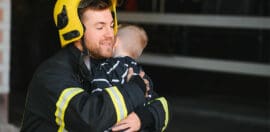Keeping children safe in emergencies

Save the Children staff setting up a child friendly space in the Bairnsdale evacuation centre.
15 December 2020 at 7:15 am
Child Wise and Save the Children join forces to deliver timely training.
We know that in any emergency children are always the most vulnerable. In Australia, natural disasters, including bushfires, floods, cyclones and other extreme weather events are on the rise. These disasters can have enormous long-term effects on an individual’s emotional wellbeing, especially children and young people.
During the 2019-20 bushfires, children’s needs were widely misunderstood and overlooked. Services for children were not regarded as essential, and there was no systematic mechanism to ensure their needs were adequately met throughout the crisis.
Children’s needs are unique during an emergency or crisis
Matt Gardiner, Save the Children’s executive director of Australian services, said unfortunately, the bushfire response did not adequately cater to the unique needs of children.
“And as a result many suffered unnecessarily when appropriate support could have alleviated this,” Gardiner said.
“Lots of children also stayed in evacuation centres that were chaotic and filled with long queues and exhausted and overwhelmed people. It was distressing for adults, let alone children.”
It is critical that the support provided during emergencies is well coordinated and delivered in partnership with state and local agencies and that children’s unique needs and all safeguarding requirements are carefully considered before, during and after disaster.
Professionals will learn how to include children’s needs and rights in emergency management planning
In order to address these needs and support others within the sector, Save the Children and Child Wise have joined forces to develop Keeping Children Safe in Emergencies, a two-hour training that provides an overview and critical insight into how to keep children and families safe from harm during times of crisis and uncertainty.
The training focuses on ensuring children’s needs and rights are included in future emergency management planning. It outlines best practice for delivering child friendly spaces and how to maintain a child-safe culture throughout a response. Keeping Children Safe in Emergencies is designed to build the capacity of communities to support the wellbeing of children before, during and after disaster.
Commencing recently in November, the training has been extremely well attended and received – evidence of the need for it in the community.
“The session was engaging and interactive, content was insightful and relevant, the session was one of the best training facilitated sessions I have experienced in a virtual world. Thank you.” – Training participant, 11 November 2020.
Applying lessons learned from the 2019-20 bushfire response
The idea to develop Keeping Children Safe in Emergencies came out of Save the Children’s 2019-20 bushfire response. During this time, Save the Children was able to set up child friendly spaces within relief or recovery centres in 17 communities, giving nearly 1,000 children from three months to 16 years a safe space to develop, learn, play, recover and process their experiences.

Image: Sacha Myers, Save the Children.
“This service has meant so much to us. We have been through a bushfire before and there wasn’t a kids’ space set up. This has made the biggest difference so we can talk to council and our son also has a chance to have some fun amongst all the stress.” – Parent at Bega Valley Recovery Centre.
After the response, Save the Children reached out to Child Wise, Australia’s leading child safeguarding experts with nearly 30 years of experience, to review and assess their domestic response and help identify ways to strengthen child safeguarding operations.
Due to continued demand, the two organisations are now looking at expanding their initial training to develop a comprehensive two-day training and coaching package that includes sessions on best practice in child participation.
Going beyond child friendly spaces to deliver a comprehensive emergency response
In addition to child friendly spaces, Save the Children provides a range of psychosocial supports to children and families, and is a technical and operational expert in keeping children safe in times of crisis, developed over many years globally and in Australia.
To date, Save the Children continues to remain in bushfire-affected communities providing vital recovery support through Journey of Hope which helps children process what they’ve been through, normalise their emotions and build resilience for the future. This highly-evidenced in-school model has reached 684 children in 13 schools since July. Save the Children also provides training on child participation approaches and how to embed these principles into local decision-making processes and emergency management plans.
If you would like more information about setting up a child friendly space in your evacuation or recovery centre or information about one of our longer-term recovery programs, please reach out to reem.hasib@savethechildren.org.au
Just one part of a broader child safety training suite
Keeping Children Safe in Emergencies is just one of a suite of child safety training programs Child Wise delivers to a range of organisations, leadership teams, staff and volunteers that work or engage with children and young people in their workplace. Our training programs, as well as coaching and consulting services are designed to equip participants with vital knowledge and skills, including identifying risks to children, responding to concerns and allegations of harm to children, strengthening organisational child safeguarding policies and practices in line with state and national child safe standards and principles and empowering children and hearing their voice in decision making.
If you are interested in attending a Child Wise training or discussing any of our coaching and consultation services, please visit the Child Wise website, and/or email us at info@childwise.org.au.







